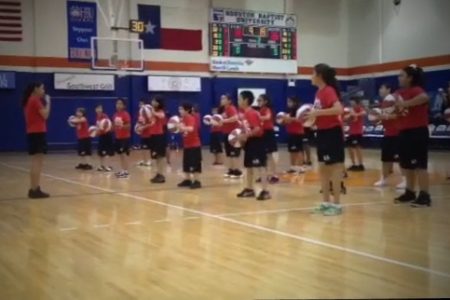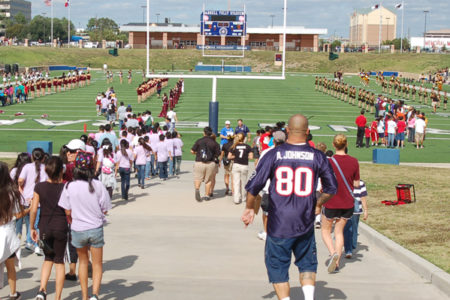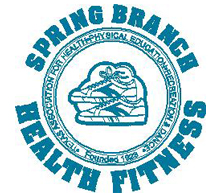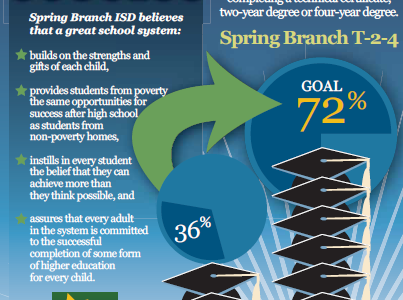Share On Social!
Kids at Westwood Elementary School in Houston lacked programs to keep them active after classes ended each day. Samuel Karns, a health fitness instructor/coach at Westwood, decided to step up to the challenge and find a way to bring more exercise and sport related activities to keep his students moving. His work resulted in a series of afterschool fitness clubs, an afterschool intermural sports program, a student-led school health advisory council (K-SHAC) for elementary-school students, an action based learning lab and a one-of-a-kind district-wide initiative to bring physical activity to sixth-graders.
Emergence
Awareness: In fall 2009, Samuel Karns was only a few months into his job as a health fitness

instructor/coach at Westwood Elementary School in the Spring Branch Independent School District (Spring Branch ISD) in Houston. He began to notice something not too uncommon for kids returning to school from summer vacation: they were a bit heavier than usual.
But what had changed?
To Karns the answer seemed obvious; the children had not been getting enough physical activity over the summer. Then the school’s annual FitnessGram reports—state-mandated reports that assess student fitness and activity levels—from the previous year arrived and the results were not too pleasing. Many of his students’ BMIs were higher than normal, which put them in the overweight and obese categories.
Learn/ Frame Issue: At the time, there were limited afterschool activities available to students at Westwood.
The developmental and enrichment programs that did exist offered very little moderate-to-vigorous physical activity (MVPA).
He also said a rule that children aren’t allowed to participate in University interscholastic

League (UTL) sports until seventh grade limits their opportunities to participate in sports.
“There were times when students were just standing around, when they should be getting 75-80% of moderate-to-vigorous physical activity,” Karns said.
Having been trained as a health fitness educator, Karns strongly believed in the connection between physical activity and learning.
He also felt strongly that if he could get kids into after school physical activity programs, that it would not only transform their health, but also inspire them to continue with their education and succeed in life.
Karns began to learn of some of the challenges that students at Westwood faced. For instance, the majority of students come from predominantly Latino (81.4%), low-income homes (91.2%) and according to the Texas Tribune, more than half of the school’s students had limited English proficiency. He also learned that few students (approximately 36%) who graduated from the district went on to complete a degree beyond their high school education.
Westwood elementary principal Kay Kennard was also concerned about the lack of afterschool programs and wanted to bring more opportunities to students. She also knew that many parents worked long hours and needed programing to be available for their children after school.
“It’s not just about academics. It’s about the whole child,” Kennard said. “When I spoke to Samuel about the direction I wanted our fine arts and PE programs to go, we looked at our mission through the lens of a whole child approach.”
Many of the school’s families cite high costs as a reason they do not enroll their children in private organizations’ physical activity  programs for elementary school children.
programs for elementary school children.
“It’s not feasible for families of five of six to pay for these types of programs,” Karns said. “I had one parent tell me that she wanted to enroll her daughter in a program, but that wouldn’t be fair to the other siblings.”
This reinforced Karn’s belief in establishing a broad base of afterschool fitness opportunities at Westwood.
“My whole philosophy is keeping the kids active and to really provide them with opportunities that they probably wouldn’t get because no one else would do it,” Karns said.
Development
Education: His two main initial ideas—afterschool programs and intramural sports for Westwood Elementary School—needed to pass muster among school leaders.
Karns brought his ideas to Principal Kennard, and Rebecca Fuchs, Spring Branch ISD director of student wellness, and they identified some funding opportunities and partnerships that could help bring afterschool programs to Westwood.
“When Samuel first came to us we welcomed the enthusiasm,” Fuchs said. “I s aid let’s hear what you would like to do and make it happen.”
aid let’s hear what you would like to do and make it happen.”
He also reached out to the Houston Parks and Recreation Department (HPARD) and found out that at the time they had an intramural sports program designed for middle-school students, which he thought he might be able to apply to elementary-school students.
He then shared his intramural sports plans with Fuchs and Kennard.
Both were delighted by the prospect of introducing more after school physical activity programs, but they suggested that Karns start by implementing a curriculum the district had for a basketball performance club.
“We started using the Players in Progress curriculum and then we used the Teams of Tomorrow program. Fuchs said. “Now we have a hybrid of both curriculums.”
Karns took the suggestion and worked to create the school’s first basketball performance group called Students Offering Academic Relationships (SOAR), in hopes it would be a precursor to an intramural sports program.
“I spoke with Samuel every week to support his progress.” Fuchs said. I wanted to make sure to remove all barriers early on that could create problems to the finished product.”
Mobilization: Karns, who developed the SOAR basketball performance program based on his alterations of existing curriculum, introduced the program in August 2009 to parents at an open house night. He explained that the program would introduce 4th and 5th graders to basketball and allow the children to perform and take trips to venues such as high schools and universities, where they could learn more about athletic and academic opportunities available at higher grade levels.
“Through afterschool programs like this, we can take kids to different universities and plant the idea of college in their head,” Karns said.
Kennard was equally as enthusiastic about the idea of taking Westwood students to visit institutions of higher education.
“We just believe that when kids are given the opportunity to do something, they are going to do phenomenal things,” Kennard said. “It’s all about choices that you give, that make or break a child…I grew up in an area of great need and one of my teachers took me to a college that I ended up going to, so that’s the first step.”
At the open house, Karns used a sign-up sheet to recruit his first group of SOAR performers. Despite not having any funding at the time, in fall 2009, Karns launched the SOAR program at Westwood.
“People would ask, ‘Why do you do it?’” Karns said. He said, for him, “It’s not about the pay.”
The program averaged 50 participants a year. During its second year, Karns recruited some of his former students who were now in sixth grade to help train the SOAR team. In 2010, the program won an Award for Excellence in Texas School Health, which provided a $1,000 grant from the Texas Department of State Health Services to keep it running.
“This program delivers more than just basketball skills; it teaches responsibility, respect and improves communication between the students, parents and the school,” Karns said.
Karns was motivated to add more opportunities for kids to be active. He identified, applied for, and was awarded a National Association for Sport and Physical Education (NASPE) grant to team Westwood with another elementary school (Pine Shadows), to start the Partners Actively Coordinating Exercise (PACE) program—to train students of all ages to run a 5K. He also brought other programs to the school like Girls on the Run (GOTR)—a nationwide program that uses a 12-week curriculum to train and empower girls to run a 5K.
With these successes over two years, Karns decided to resurrect his idea for creating a systems change at his school—adding an afterschool intramural sports program for elementary kids.
So he reached out to HPARD officials to see if they had any resources to help support a program like this at Westwood.
HPARD had lined up a group of volunteers from the business community who were interested in serving as coaches and set up a meeting so that Karns could meet the volunteers—unfortunately nobody showed up. Although the turnout was disappointing, Karns did not give up, instead organizing his own meetings with Westwood’s parents to invite them to participate as coaches.
Debate: Karns initially wanted to have his students play games against other schools, but he soon learned that he would not be able to do this due to a UIL policy that does not allow elementary schools to compete against each other.
“We had to align completely with all the policies.” Fuchs said. “UIL has a policy concerning intra-district competition.”
For the time being he envisioned that the intramural program could have Westwood students play against each other during afterschool or Saturday-morning games.
Enactment
Activation: With his intramural plans taking shape, Karns reached out to parents at another open house event, where he took names of parents to organize future meetings to inform about the program.
“I told them I want to do this, but I need your help…At first parents were afraid that they didn’t have the skills necessary to coach,” Karns said. “But then I shared with them the story of my father.”
Karns explained that as a child, his mother signed up his father to coach soccer without him having much knowledge of the sport. His father took the role seriously and learned all there was to know about the sport.
Hearing this story encouraged a few parents to volunteer as coaches. Karns also reached out to some local high schools and colleges to see if any students would be interested in gaining some coaching experience and volunteering their time to coach elementary students.
Frame Policy: The plan was to expose Westwood students to a variety of sports like flag football, basketball, volleyball, and soccer, and to provide an afterschool physical activity program to children regardless of their socio-economic status (SES).
Volunteers would help run the program and introduce kids to the fundamental movements that go with each sport. Students would learn a new sport every 6 weeks. Practices would be held from 3:15-5 p.m. Mondays and games would be held 8-11 a.m. every other Saturday. At first, HPARD would participate by sending a referee to supervise games and providing red and blue jerseys for students to wear.
Karns also made sure to the design the program so that it lined up with the district’s mission of educating the whole child by providing a safe and supportive place to be active. So each participant would have to maintain good academic standing to play.
Change: In fall 2010, the intramural sports program debuted at Westwood. The co-ed program, which moved ahead with the planned Monday practices and bi-weekly Saturday games, started with six weeks of flag-football, and then transitioned to include volleyball, basketball, and soccer.
According to Kennard, all volunteer coaches were required to be cleared by the district before working with students. Additionally an administrator is required to be at the Westwood campus during games, when parents come out to watch their children. Parents with children participating in the intermural sports program were asked to sign a permission slip and abide by the rules of participation, which included:
- Following all rules at Westwood;
- Maintaining good academic standing; and
- Being picked up from practices promptly at 5 p.m.
Implementation
Implementation: Karns said the new program is giving students more opportunities to be healthy and active, and they are increasingly participating.
About 20 students joined in Year 1, and 50 in Year 2. What really amazed Karns was that families were coming out on Saturday morning to watch their children play.
“The turnout just blew me away,” Karns said. “They brought everyone: moms, dads, grandparents.”
In years 2 and 3, parents and high school students showed an increased interest in participating as coaches.
“I have high school kids who have dedicated over 100 hours of their time,” Karns said.
He said this type of arrangement is mutually beneficial to both parties, because elementary school children look up to high-school students, and high-school students who are planning on becoming coaches get the experience of learning to coach a team.
“When a high-school student walks onto an elementary campus, they’re kind of like a rock star to these kids,” Karns said.
Children in the intermural sports program were also given t-shirts. “There’s something about a name and a logo that unifies them,” Kennard said.
Equity: Expansion of afterschool activities has by no means ended with the implementation of the intermural sports program at Westwood.
In addition to the SOAR program and intermural sports program, Karns has helped bring numerous physical activity and health education opportunities to his students. At the suggestion of Fuchs, Karns and Sandy Bristow, program director for the Oliver Foundation, led efforts to create the district’s very first kids school health advisory council (KSHAC), and now at least six other schools have followed suit.
The KSHAC created their own mission statement and supported a number of healthy lifestyle events including: the creation and placement of healthy signs in school hallways, a family wellness night that offered Zumba, the creation of a school garden, and a red ribbon rally at city hall.
Through the Oliver Foundation, Westwood was able to acquire $30,000 worth of equipment to establish an action based learning lab for the school. Now kindergarteners can learn while enhancing their gross motor skills, and students from other grade levels can integrate the use of technology with movement and academics.
“One of our former PE teachers is now our math specialist and she uses the action based learning lab to incorporate movement with math lessons,” Principal Kennard said.
More recently, Karns partnered with Fuchs to develop a strategy to bring more physical activity to sixth-graders and additional elementary schools. The Advanced Movers Initiative serves to fill the void left while elementary-school students make the transition into middle school. Through this program students now have the opportunity to participate in extracurricular activities and enroll in a sixth-grade developmental athletics class.
“We included many teachers and stakeholders in developing the framework and the 6th grade developmental athletics curriculum…counselors, parents, administrators,” Fuchs said. “Not one group started Advanced Movers. It evolved from everyone in Spring Branch ISD taking care of students.”
Now, according to Karns, students from other elementary schools are able to participate in Saturday morning games with Westwood students, so long as students play on mixed teams.
Sustainability: Although funding for the HPARD intermural sports program has ended, the community’s dedication and Karns’ leadership have kept the program running at Westwood.
With funding from Springs Branch Education Foundation, a federal ACE grant, a Memorial Herman grant, and others, the district’s Advanced Movers Initiative has been able to bring programs like the USTA Tennis Summer Program and Soccer for Success to kids with the highest level of need.
In the future, Karns hopes to expand the program into all middle and elementary schools.
“I don’t want to keep it just in Spring Branch. My belief is that every elementary school should run the same type of programs,” Karns said. “My goal is to pass it on.”
Additional Links:
Animoto: Intramural Sports Program
Animoto: Walk For Wellness (Culminating Event for Running Program)
Animoto: Advanced Movers Year at a glance 2012-2013
Animoto: USTA Summer 2013
Animoto: K-SHAC at the Red Ribbon Rally Day at City Hall
Brochure about the Advanced Movers Initiative
SBISD Athletics News: Students Put T-2-4 Into Action with Advanced Movers Initiative
The National Association for Sport and Physical Education’s (NASPE) Position Statement on Before and After School Physical Activity And Intramural Sport Programs
Guidelines for After School Physical Activity and Intramural Sport Programs
This success story was produced by Salud America! with support from the Robert Wood Johnson Foundation.
The stories are intended for educational and informative purposes. References to specific policymakers, individuals, schools, policies, or companies have been included solely to advance these purposes and do not constitute an endorsement, sponsorship, or recommendation. Stories are based on and told by real community members and are the opinions and views of the individuals whose stories are told. Organization and activities described were not supported by Salud America! or the Robert Wood Johnson Foundation and do not necessarily represent the views of Salud America! or the Robert Wood Johnson Foundation.
ABOUT THE PROGRAM
Salud America! The RWJF Research Network to Prevent Obesity Among Latino Children is a national program of the Robert Wood Johnson Foundation. The program aims to educate researchers, decision-makers, community leaders, and the public in contributing toward healthier Latino communities and seeking environmental and policy solutions to the epidemic of Latino childhood obesity. The network is directed by the Institute for Health Promotion Research at the University of Texas Health Science Center at San Antonio.
For more information, visit http://www.salud-america.org.
|
By The Numbers
84
percent
of Latino parents support public funding for afterschool programs
This success story was produced by Salud America! with support from the Robert Wood Johnson Foundation.
The stories are intended for educational and informative purposes. References to specific policymakers, individuals, schools, policies, or companies have been included solely to advance these purposes and do not constitute an endorsement, sponsorship, or recommendation. Stories are based on and told by real community members and are the opinions and views of the individuals whose stories are told. Organization and activities described were not supported by Salud America! or the Robert Wood Johnson Foundation and do not necessarily represent the views of Salud America! or the Robert Wood Johnson Foundation.



